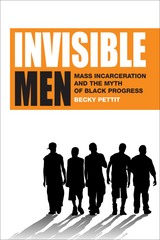2 books about Pettit, Becky

Gendered Tradeoffs
Women, Family, and Workplace Inequality in Twenty-One Countries
Becky Pettit
Russell Sage Foundation, 2009
Gender inequality in the workplace persists, even in nations with some of the most progressive laws and generous family support policies. Yet the dimensions on which inequality is measured—levels of women's employment, number of hours worked, sex segregation by occupations and wages—tell very different stories across industrialized nations. By examining federally guaranteed parental leave, publicly provided child care, and part-time work, and looking across multiple dimensions of inequality, Becky Pettit and Jennifer Hook document the links between specific policies and aggregate outcomes. They disentangle the complex factors, from institutional policies to personal choices, that influence economic inequality. Gendered Tradeoffsdraws on data from twenty-one industrialized nations to compare women's and men's economic outcomes across nations, and over time, in search of a deeper understanding of the underpinnings of gender inequality in different labor markets. Pettit and Hook develop the idea that there are tradeoffs between different aspects of gender inequality in the economy and explain how those tradeoffs are shaped by individuals, markets, and states. They argue that each policy or condition should be considered along two axes—whether it promotes women's inclusion in or exclusion from the labor market and whether it promotes gender equality or inequality among women in the labor market. Some policies advance one objective while undercutting the other. The volume begins by reflecting on gender inequality in labor markets measured by different indicators. It goes on to develop the idea that there may be tradeoffs inherent among different aspects of inequality and in different policy solutions. These ideas are explored in four empirical chapters on employment, work hours, occupational sex segregation, and the gender wage gap. The penultimate chapter examines whether a similar framework is relevant for understanding inequality among women in the United States and Germany. The book concludes with a thorough discussion of the policies and conditions that underpin gender inequality in the workplace. The central thesis of Gendered Tradeoffs is that gender inequality in the workplace is generated and reinforced by national policies and conditions. The contours of inequality across and within countries are shaped by specific aspects of social policy that either relieve or concentrate the demands of care giving within households—usually in the hands of women—and at the same time shape workplace expectations. Pettit and Hook make a strong case that equality for women in the workplace depends not on whether women are included in the labor market but on how they are included.
[more]

Invisible Men
Mass Incarceration and the Myth of Black Progress
Becky Pettit
Russell Sage Foundation, 2012
For African American men without a high school diploma, being in prison or jail is more common than being employed—a sobering reality that calls into question post-Civil Rights era social gains. Nearly 70 percent of young black men will be imprisoned at some point in their lives, and poor black men with low levels of education make up a disproportionate share of incarcerated Americans. In Invisible Men, sociologist Becky Pettit demonstrates another vexing fact of mass incarceration: most national surveys do not account for prison inmates, a fact that results in a misrepresentation of U.S. political, economic, and social conditions in general and black progress in particular. Invisible Men provides an eye-opening examination of how mass incarceration has concealed decades of racial inequality. Pettit marshals a wealth of evidence correlating the explosion in prison growth with the disappearance of millions of black men into the American penal system. She shows that, because prison inmates are not included in most survey data, statistics that seemed to indicate a narrowing black-white racial gap—on educational attainment, work force participation, and earnings—instead fail to capture persistent racial, economic, and social disadvantage among African Americans. Federal statistical agencies, including the U.S. Census Bureau, collect surprisingly little information about the incarcerated, and inmates are not included in household samples in national surveys. As a result, these men are invisible to most mainstream social institutions, lawmakers, and nearly all social science research that isn't directly related to crime or criminal justice. Since merely being counted poses such a challenge, inmates' lives—including their family background, the communities they come from, or what happens to them after incarceration—are even more rarely examined. And since correctional budgets provide primarily for housing and monitoring inmates, with little left over for job training or rehabilitation, a large population of young men are not only invisible to society while in prison but also ill-equipped to participate upon release. Invisible Men provides a vital reality check for social researchers, lawmakers, and anyone who cares about racial equality. The book shows that more than a half century after the first civil rights legislation, the dismal fact of mass incarceration inflicts widespread and enduring damage by undermining the fair allocation of public resources and political representation, by depriving the children of inmates of their parents' economic and emotional participation, and, ultimately, by concealing African American disadvantage from public view.
[more]
READERS
Browse our collection.
PUBLISHERS
See BiblioVault's publisher services.
STUDENT SERVICES
Files for college accessibility offices.
UChicago Accessibility Resources
home | accessibility | search | about | contact us
BiblioVault ® 2001 - 2024
The University of Chicago Press









